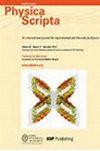Synergistic effects of hydrothermally decorated Ag nanoparticles over rGO for antibacterial activities
IF 2.6
3区 物理与天体物理
Q2 PHYSICS, MULTIDISCIPLINARY
引用次数: 0
Abstract
Abstract Antibacterial activity of the silver decorated reduced graphene oxide (Ag-rGO) nanocomposites have been investigated against E. coli as a model for gram-negative bacteria. The effect of temperature during the hydrothermal treatment of Ag-rGO nanocomposites synthesized by simultaneous reduction of GO and AgNO 3 over the antibacterial activity has been studied. The composite samples were further reduced hydrothermally at different temperatures, viz. 100 °C, 150 °C, and 200 °C for 24 h to integrate silver nanoparticles (AgNPs) into rGO. Variations in the hydrothermal treatment temperature allowed alterations in the morphology and particle size of the AgNPs. The AgNPs grown at room temperature are in bunches and smaller sizes, whereas the hydrothermally treated samples have uniformly distributed bigger AgNPs. The particle size of AgNPs on rGO grows from 45 nm at room temperature to 65 nm and 220 nm in the hydrothermally treated samples at 150 °C and 200 °C, respectively. The antibacterial activity of the Ag-rGO composite has been observed to be size dependent. The Ag-rGO composite hydrothermally treated at 150 °C, having a particle size of ∼65 nm, has been observed to have the highest activity; the zone of inhibition is 3.4 ± 2.8 cm. The Ag nanocrystallite’s edges and defects in the rGO sheets together destroy the bacterial cells in a series of stages, ultimately resulting in cell death and high antibacterial activity.水热修饰银纳米颗粒对氧化石墨烯的协同抑菌作用
摘要研究了银修饰的还原氧化石墨烯(Ag-rGO)纳米复合材料对大肠杆菌的抗菌活性,并将其作为革兰氏阴性菌的模型。研究了水热处理氧化石墨烯与agno3同时还原合成的Ag-rGO纳米复合材料时温度对其抗菌活性的影响。复合样品在100°C、150°C和200°C的不同温度下进一步水热还原24 h,使银纳米粒子(AgNPs)整合到还原氧化石墨烯中。水热处理温度的变化使AgNPs的形态和粒径发生了变化。室温下生长的AgNPs呈束状,尺寸较小,而水热处理的样品具有均匀分布的较大AgNPs。室温条件下,氧化石墨烯表面AgNPs的粒径从45 nm增大到150℃和200℃条件下的65 nm和220 nm。Ag-rGO复合材料的抗菌活性已被观察到依赖于尺寸。经150°C水热处理的Ag-rGO复合材料的粒径为~ 65 nm,具有最高的活性;抑制区为3.4±2.8 cm。银纳米晶的边缘和氧化石墨烯薄片中的缺陷在一系列阶段共同破坏细菌细胞,最终导致细胞死亡和高抗菌活性。
本文章由计算机程序翻译,如有差异,请以英文原文为准。
求助全文
约1分钟内获得全文
求助全文
来源期刊

Physica Scripta
物理-物理:综合
CiteScore
3.70
自引率
3.40%
发文量
782
审稿时长
4.5 months
期刊介绍:
Physica Scripta is an international journal for original research in any branch of experimental and theoretical physics. Articles will be considered in any of the following topics, and interdisciplinary topics involving physics are also welcomed:
-Atomic, molecular and optical physics-
Plasma physics-
Condensed matter physics-
Mathematical physics-
Astrophysics-
High energy physics-
Nuclear physics-
Nonlinear physics.
The journal aims to increase the visibility and accessibility of research to the wider physical sciences community. Articles on topics of broad interest are encouraged and submissions in more specialist fields should endeavour to include reference to the wider context of their research in the introduction.
 求助内容:
求助内容: 应助结果提醒方式:
应助结果提醒方式:


